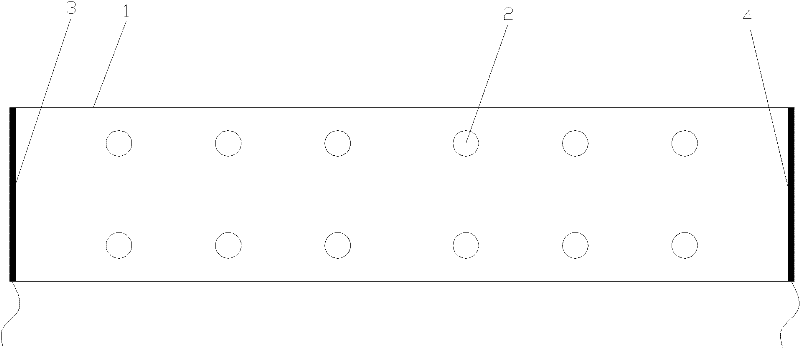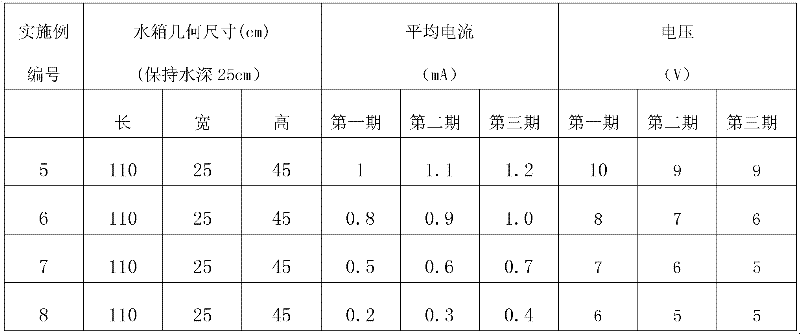External physical stimulation method for promoting secretion of pearl oysters
A technology of physical stimulation and pearl clams, applied in fish farming, application, climate change adaptation, etc., can solve the problems of declining pearl quality, destroying water quality, reducing the proportion of high value-added products, etc., to optimize the structure of pearl products and shorten the growth rate. cycle, the effect of improving the quality of beading
- Summary
- Abstract
- Description
- Claims
- Application Information
AI Technical Summary
Problems solved by technology
Method used
Image
Examples
Embodiment 1
[0056] Embodiment 1: The industrialized environment of this embodiment: adopt vitreous body water tank 1, the inside dimension of tank body is: length 220cm, width 25cm, height 45cm, store water body in the tank, and keep water depth 25cm. Requirements for water quality: The water must be a non-polluted water body, with a pH value of 7.5-8.5, a water temperature of 25-28 degrees Celsius, sufficient dissolved oxygen in the water, and rich nutrients. Cultivate pearl mussels 2 in the water, adopt the culture method of hanging pearls, and the culture density is: the pearl mussels are evenly distributed in the box with an array of 2 (wide) X 6 (long), such as figure 1 shown. A pair of negative and positive electrodes are placed on the inner wall close to the wide side of the water tank. In this example, stainless steel electrode plates 4 and 3 are used. The width of the electrode plates is equal to the width of the inner side of the water tank. The electrode plates are immersed in ...
Embodiment 2-4
[0082] Embodiments 2-4: The difference between these three embodiments and Embodiment 1 is that different stimulation current intensities and voltages between electrodes as shown in Table 1 are used.
[0083] Stimulation current intensity and inter-electrode voltage of table 1 embodiment 2-4
[0084]
[0085] Comparative experiments: 4 comparative experiments corresponding to the above Examples 1-4 were carried out. The difference between the comparative experiment and Examples 1-4 is that it lacks the electric current stimulation process of the present invention, and other contents are the same: a vitreous water tank is adopted, and the inside size of the casing is: long 220cm, wide 25cm, high 45cm, and the water body is stored in the box. And keep the water depth 25cm. The water is a pollution-free water body, with a pH value of 7.5-8.5, a water temperature of 25-28 degrees Celsius, sufficient dissolved oxygen in the water, and rich in various nutrients. Pearl mussels a...
Embodiment 5-8
[0087] Embodiment 5-8: the industrialized environment that the inventive method is implemented: adopt vitreous water tank, the inside size of box body is: length 110cm, width 25cm, height 45cm, store water body in the box, and keep water depth 25cm. Requirements for water quality: The water must be a non-polluted water body, with a pH value of 7.5-8.5, a water temperature of 25-28 degrees Celsius, sufficient dissolved oxygen in the water, and rich nutrients. Pearl mussels are cultivated in the water, and the culture method of hanging pearls is adopted, and the culture density is: the pearl mussels are uniformly distributed in an array of 2 (width)×4 (length) in the box. A pair of negative and positive electrodes are placed on the inner wall close to the wide side of the water tank. In this example, stainless steel electrode plates are used. The width is equal to that of the inner side of the water tank. The electrode plates are immersed in water, and the electrode plates are co...
PUM
 Login to View More
Login to View More Abstract
Description
Claims
Application Information
 Login to View More
Login to View More - R&D Engineer
- R&D Manager
- IP Professional
- Industry Leading Data Capabilities
- Powerful AI technology
- Patent DNA Extraction
Browse by: Latest US Patents, China's latest patents, Technical Efficacy Thesaurus, Application Domain, Technology Topic, Popular Technical Reports.
© 2024 PatSnap. All rights reserved.Legal|Privacy policy|Modern Slavery Act Transparency Statement|Sitemap|About US| Contact US: help@patsnap.com










